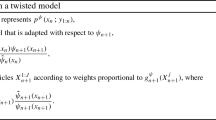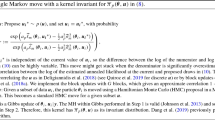Abstract
This article proposes an efficient Bayesian inference for piecewise exponential hazard (PEH) models, which allow the effect of a covariate on the survival time to vary over time. The proposed inference methodology is based on a particle smoothing algorithm that depends on three particle filters. Efficient proposal (importance) distributions for the particle filters tailored to the nature of survival data and PEH models are developed using the Laplace approximation of the posterior distribution and linear Bayes theory. The algorithm is applied to both simulated and real data, and the results show that it is faster and more efficient than a state-of-the-art MCMC sampler, and scales well in high-dimensional and relatively large data.



Similar content being viewed by others
References
Arulampalam MS, Maskell S, Gordon N, Clapp T (2002) A tutorial on particle filters for online nonlinear/non-Gaussian Bayesian tracking. IEEE Trans Signal Process 50(2):174–188
Briers M, Doucet A, Maskell S (2010) Smoothing algorithms for state-space models. Ann Inst Stat Math 62(1):61–89
Burke K, MacKenzie G (2017) Multi-parameter regression survival modeling: an alternative to proportional hazards. Biometrics 73(2):678–686
Carpenter J, Clifford P, Fearnhead P (1999) Improved particle filter for nonlinear problems. IEE Proc Radar Sonar Navig 146(1):2–7
Cox RD (1972) Regression models and life tables (with discussion). J R Stat Soc 34:187–220
Das S, Dey DK (2013) On dynamic generalized linear models with applications. Methodol Comput Appl Prob 15(2):407–421
Di Crescenzo A, Longobardi M (2004) A measure of discrimination between past lifetime distributions. Stat Prob Lett 67(2):173–182
Doucet A, De Freitas N, Gordon N (2001) An introduction to sequential Monte Carlo methods. In: Sequential Monte Carlo methods in practice. Springer, pp 3–14
Doucet A, Godsill S, Andrieu C (2000) On sequential Monte Carlo sampling methods for Bayesian filtering. Stat Comput 10(3):197–208
Fahrmeir L (1994) Dynamic modelling and penalized likelihood estimation for discrete time survival data. Biometrika 81(2):317–330
Fahrmeir L, Kneib T (2011) Bayesian smoothing and regression for longitudinal, spatial and event history data. Oxford University Press, New York
Fahrmeir L, Wagenpfeil S (1996) Smoothing hazard functions and time-varying effects in discrete duration and competing risks models. J Am Stat Assoc 91(436):1584–1594
Fearnhead P, Wyncoll D, Tawn J (2010) A sequential smoothing algorithm with linear computational cost. Biometrika 97(2):447–464
Frühwirth-Schnatter S (1994) Data augmentation and dynamic linear models. J Time Ser Anal 15(2):183–202
Gamerman D (1991) Dynamic Bayesian models for survival data. Appl Stat 40:63–79
Gamerman D (1998) Markov Chain Monte Carlo for dynamic generalised linear models. Biometrika 85(1):215–227
Gelman A, Hwang J, Vehtari A (2014) Understanding predictive information criteria for Bayesian models. Stat Comput 24(6):997–1016
Geweke J (1989) Bayesian inference in econometric models using Monte Carlo integration. Econom J Econom Soc 57:1317–1339
Gordon NJ, Salmond DJ, Smith AF (1993) Novel approach to nonlinear/non-Gaussian Bayesian state estimation. In: IEE Proceedings F (Radar and Signal Processing), IET, vol 140, pp 107–113
Hemming K, Shaw J (2002) A parametric dynamic survival model applied to breast cancer survival times. J R Stat Soc Ser C (Applied Statistics) 51(4):421–435
Jensen G, Torp-Pedersen C, Hildebrandt P, Kober L, Nielsen F, Melchior T, Joen T, Andersen P (1997) Does in-hospital ventricular fibrillation affect prognosis after myocardial infarction? Eur Heart J 18(6):919–924
Murray TA, Hobbs BP, Sargent DJ, Carlin BP (2016) Flexible Bayesian survival modeling with semiparametric time-dependent and shape-restricted covariate effects. Bayesian Anal 11(2):381
Pitt MK, Shephard N (1999) Filtering via simulation: auxiliary particle filters. J Am Stat Assoc 94(446):590–599
Sargent DJ (1997) A flexible approach to time-varying coefficients in the Cox regression setting. Lifetime Data Anal 3(1):13–25
Scheike T (2009) Timereg: timereg package for flexible regression models for survival data. R package version 1.2-4
Villani M, Kohn R, Nott DJ (2012) Generalized smooth finite mixtures. J Econom 171(2):121–133
Wagner H (2011) Bayesian estimation and stochastic model specification search for dynamic survival models. Stat Comput 21(2):231–246
West M, Harrison PJ, Migon HS (1985) Dynamic generalized linear models and Bayesian forecasting. J Am Stat Assoc 80(389):73–83
Acknowledgements
I would like to thank Mattias Villani, Gebrenegus Ghilagaber and Kevin Bruke for their constructive comments, and Helga Wagner for sharing the code for the auxiliary mixture sampler approach.
Author information
Authors and Affiliations
Corresponding author
Additional information
Publisher's Note
Springer Nature remains neutral with regard to jurisdictional claims in published maps and institutional affiliations.
Codes for the article available at: https://github.com/Pmune/PSLiB
Details on the approximation of the posterior moments of the linear predictor
Details on the approximation of the posterior moments of the linear predictor
Given the structure of the likelihood (6), the model parameter \(\uplambda _{j}\) has a conjugate \(\text {Gamma}(\alpha _{j},\psi _{j})\) prior distribution, which implies that the marginal posterior of \(\uplambda _{j}\) is \(\text {Gamma}(\alpha _{j}+d_{j},\psi _{j}+t_{j})\). Taking into account the Jacobian of the transformation \(\eta _{j}=\ln \uplambda _{j}\), it can be shown that
where \({\mathbf {t}}_{1:i,j}\) is the set of exposure times for the first i individuals observed in the interval \(I_{j}\). In order to apply the conditional expectations (21), we need to compute the first and second derivatives of the log of (27)
and
From the first derivative, one can show that the mode lies at \(\hat{\eta _{j}}=\ln (\frac{\alpha _{j}+d_{j}}{\psi _{j}+t_{j}})\), which lead to the final expressions
The hyper-parameters \(\alpha _{j}\) and \(\psi _{j}\) are selected in order to match the true moments of the prior with the moments from the deterministic relationship \(\eta _{j}={\mathbf {z}}^{\prime }\varvec{\beta }_{j-1}\). This is accomplished by setting \(\ln \alpha _{j}-\ln \psi _{j}={\mathbf {z}}^{\prime }\varvec{\beta }_{j-1}\) and \(\alpha _{j}^{-1}=Q_{j}\); hence \(\psi _{j}=Q_{j}^{-1}\exp \{-{\mathbf {z}}_{i}^{\prime }\varvec{\beta }_{j-1}\}\), which proves the moments of the proposal q described in Sect. 3.3.
Rights and permissions
About this article
Cite this article
Munezero, P. Efficient particle smoothing for Bayesian inference in dynamic survival models. Comput Stat 37, 975–994 (2022). https://doi.org/10.1007/s00180-021-01155-7
Received:
Accepted:
Published:
Issue Date:
DOI: https://doi.org/10.1007/s00180-021-01155-7




